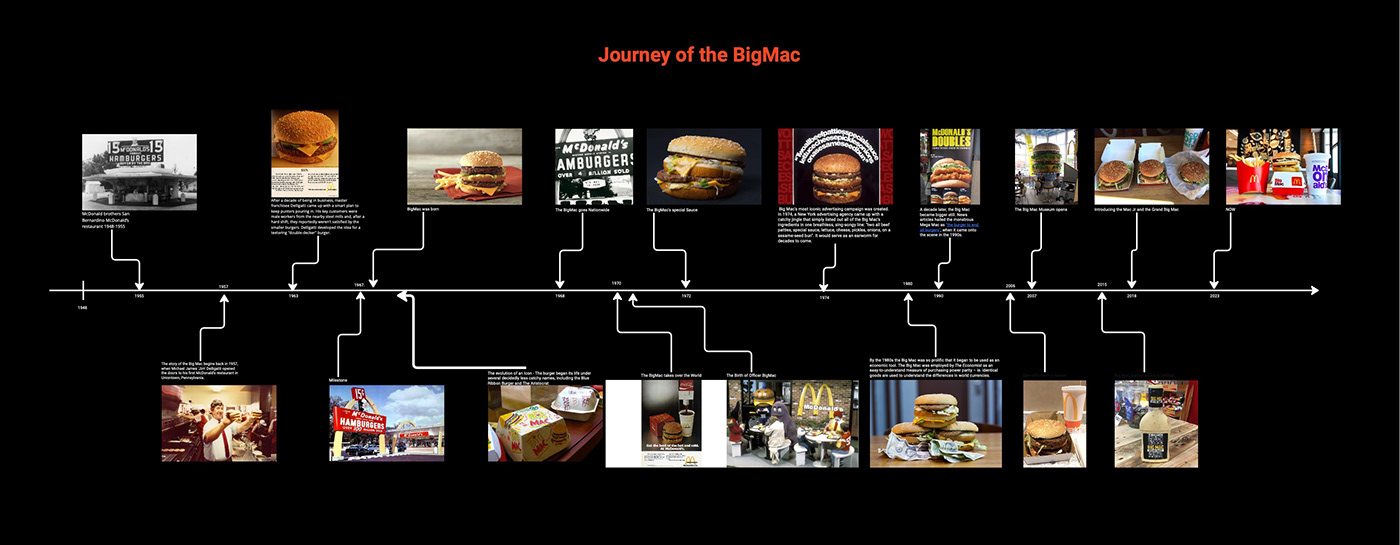Fabrication Technologies 2023
Unit 0.0.a Deconstruct: BigMac
For this first assignment, you will investigate the composition and materiality of one seemingly simple object by deconstructing it.
Select carefully one mass-produced item related to your case study (1), dismantle it (2), and arrange its elements on a neutral background. Organize its bits in families according to your own parameters —scale, material streams, embodied carbon... to name a few (3)— and extract a critical reading of it.
Produce one photograph (4) and write a brief abstract describing the item, the process, the layout, and your critical reading.

Abstract:
The Big Mac© is the flagship burger sold at McDonald's, a well-renowned fast food chain across the world. It has 7 main ingredients: The Big Mac Bun, 100% Beef Burger Patty, shredded lettuce, Big Mac Sauce, Pasteurised Process American Cheese, Pickle Slices, and onions. The beef patty is sourced locally (Mainly in Extremadura [50.4%], and Galicia [34.5%]), the cheese is a mix of ingredients (see below), and the Big Mac Sauce contains 25 ingredients (see below). The pickling ingredients are also listed below and in total, The Big Mac contains 503 calories.
The 5x6 grid is arranged from left to right based on the product category, food, packaging, and extra contents. It’s further categorized by material and size/volume.
The Big Mac© represents a milestone in a capitalist, consumerist society in which a burger could be created in an extremely short amount of time. It has been a symbol from America that perpetuates capitalism and consumerism. Because of this, it has become one of the faces of the fast-food industry however over time, alongside fast-food culture, has grown a negative connotation due to its lack of nutrition and quality. It’s been a driver of health issues such as high cholesterol, diabetes, and obesity.


EXTRA NOTES:
Cheese:
EITHER: Vegetarian Cheddar (51%) (Allergen Ingredient: MILK), Water, Vegetarian Cheese (9%) (Allergen Ingredient: MILK), Whey Powder (Allergen Ingredient: MILK), Butter (Allergen Ingredient: MILK), Emulsifying Salts (Trisodium Citrate, Citric Acid), Allergen Ingredient: MILK Proteins, Natural Cheese Flavouring (Allergen Ingredient: MILK), Salt, Colours (Beta Carotene, Paprika Extract), Anti-Caking Agent (Lecithins).
OR: Vegetarian Cheddar (51%) (Allergen Ingredient: MILK), Water, Vegetarian Cheese (9%) (Allergen Ingredient: MILK), Whey Powder (Allergen Ingredient: MILK), Butter (Allergen Ingredient: MILK), Emulsifying Salts (Trisodium Citrate, Tripotassium Citrate, Citric Acid), Allergen Ingredient: MILK Protein, Natural Cheese Flavouring (Allergen Ingredient: MILK), Salt, Colours (Carotene, Paprika Extract), Anti-Caking Agent (Lecithins).
Big Mac Sauce:
Soybean Oil, Sweet Relish (diced Pickles, Sugar, High Fructose Corn Syrup, Distilled Vinegar, Salt, Corn Syrup, Xanthan Gum, Calcium Chloride, Spice Extractives), Water, Egg Yolks, Distilled Vinegar, Spices, Onion Powder, Salt, Propylene Glycol Alginate, Garlic Powder, Vegetable Protein (hydrolyzed Corn, Soy And Wheat), Sugar, Caramel Color, Turmeric, Extractives Of Paprika, Soy Lecithin.
Pickles;
Cucumbers, Water, Distilled Vinegar, Salt, Calcium Chloride, Alum, Potassium Sorbate (preservative), Natural Flavors, Polysorbate 80, Extractives Of Turmeric (color).
Unit 0.0.a Take - Make Disposal: BigMac
During our first class together we looked into the “take-make-dispose” diagram of a pencil (see image above) (1).
For this short assignment you will emulate or reinterpret this diagram in order to analyze the processes behind the making (and unmaking) of your chosen case-study object. Use Miro’s “mind map” tool to sketch it (2) and translate it into a sankey diagram later on (3).
Write a brief abstract casting a critical reading on it (4).

Unit 0.0.a Take - Loops and Shortcuts: BigMac
During our first class we saw how Thwaites toaster could be read a series of loops and shortcuts on our current “take-make-dispose” model or production (see image above). For this last assignment of Unit 00 you will re-address your previous “take-make-dipose” diagram aiming at detecting design opportunities: loops and shortcuts in the system (1).
Produce a time-line documenting the historical context of your desing field (2). Use “facts” Miro board to include online news, data charts and press clips that support your critique (3). Use “opportunities” board to include design references, designers, companies or products working to address these issues (4).


